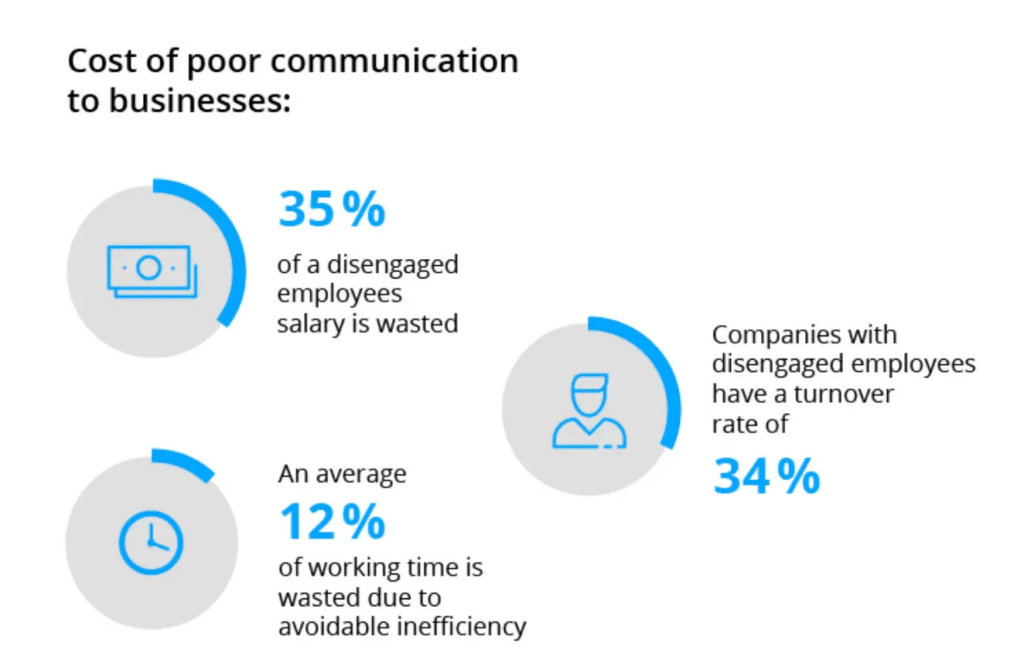The link between effective internal communications, engagement, and productivity is long-established and consistently proven. Did you know that 85% of employees feel more motivated and engaged when management ensures regular communication and updates?
In fact, companies that maintain employee engagement enjoy up to 25% higher productivity and achieve 23% greater profitability. The figure below offers some additional compelling findings related to the impact of poor communication.

All these figures emphasise the critical role of internal communications systems in creating a highly motivating, supportive, and thriving work environment. In this guide, we have compiled best practices and proven strategies to help you elevate your internal communications, enhancing teamwork and productivity.
Read on to discover how to revolutionise your workplace and unlock the full potential of your workforce.
Table of Contents
What is an ‘Internal Communications System’?
An ‘Internal Communications System’ encompasses an organisation’s primary communication framework, including the tools and processes employed to disseminate information.

However, the full perception of the concept goes beyond this basic definition, offering numerous advantages that contribute to organisational well-being. The available systems and solutions vary widely, reflecting the diverse nature of the organisations adopting them.
Traditionally, internal communication systems facilitated top-down communication, delivering news from management to employees. Contemporary systems feature employee experience platforms, promoting interaction, engagement, and content sharing.
Additionally, some organisations prioritise innovation and collaboration by adopting specialised communications tools, such as digital signage, as part of their internal communication system.
To be fully effective and successful, such systems require communications experts or champions who have the skills required to operate and monitor the system and create and deliver the messages to the target recipients.
What Are the Benefits of Internal Communication?
Effective internal communication offers a plethora of benefits that extend beyond simply keeping employees informed. It fosters engagement, motivation, unity, and connection within the workforce.
In recent years, the significance and impact of strong internal communication have become indisputable, particularly during periods of uncertainty and significant change. A well-implemented communication system can serve as the adhesive that holds an organisation together. In addition to improving productivity and profitability, it facilitates the establishment of a company culture and enhances workplace safety and security.
Acknowledging the importance of internal communications, many companies have adopted cutting-edge solutions, such as digital signage software, mobile-first technologies, and sophisticated communications techniques. All these top-notch systems help businesses position themselves for greater organisational health and employee satisfaction, delivering crucial updates directly to employees and ensuring they remain informed and connected.
What Are Some Common Internal Communication Challenges?
While indispensable for optimising business operations, Internal communication faces challenges.
Many businesses are still trying to establish the significance of these systems and their contributions to organisational well-being. A lack of management support and informational silos are among the challenges reported by internal communication professionals.
Other challenges faced by internal communicators include engaging a multigenerational workforce, comprehending employees’ needs, addressing information overload, navigating device diversity, and overcoming language barriers.
Irrespective of the multiple challenges we listed, recent trends indicate a growing understanding of the impact of communication, showcasing the advantage of having a robust internal communication system and strategy.
Internal Communications System: Tools for Internal Comms
Internal communication systems incorporate various tools and software to reach and engage employees within organisations. While non-digital channels like notice boards and company newspapers were once prevalent, they no longer meet the demands of the modern world due to limited employee engagement and reach. Consequently, digital internal communications tools and channels have become essential, enabling real-time communication, interaction with content, feedback provision, and question-asking.

The tools for internal comms range from email and instant messaging delivering updates to users’ personal mobile devices and desktops to indoor and outdoor digital posters transmitting information company-wide.
Internal Communication Systems: Tips to Boost Engagement
With practical insights into developing an effective internal communication strategy, organisations can navigate challenging times more effectively. Here are six essential steps to consider:
What’s Your Current Situation
Begin by assessing your current situation through an internal communications audit. Understanding your starting point is crucial in developing an effective strategy. Utilise a comprehensive guide to conduct your audit successfully.
Know The Who, What, and Why
Understand the target audience and the purpose of your communication to develop a relevant and impactful strategy. Gain a clear understanding of your key stakeholders, target personas, and communications team. Determine your main activities, communication goals, key messages, and stories you wish to convey.
Keep Things Simple, Visible, and Reliable
Simplicity is key in cutting through the noise. Determine how you will achieve your goals by identifying the communication channels required, the available budget, and methods for measuring the success of your communication efforts.
Also, ensure your communications are accessible and visible to your employees. Live data dashboards, digital signage displays, and interactive digital screens can go a long way in keeping everyone in your organisation on the same page.

By installing such screens strategically in your facilities, you can ensure your message reaches all target recipients. Strategic timing and implementing mandatory reads when necessary can also improve the reliability of internal communications.
Integrate Feedback Into Planning
Stay informed about trends and best practices in the communications world. Learn from other organisations in your industry and discover which tools or formats you should utilise. Keep up-to-date with the latest internal communication trends to continuously improve your strategy. Incorporate employee input to better understand their needs and preferences. By including feedback in your internal communication plan, you create a more responsive and engaging environment.
Consistent Conversation
Create a cohesive internal communication strategy by combining all the building blocks mentioned above. Promote an environment where employees can interact, engage, and express their thoughts, ensuring your internal communication plan remains sustainable and relevant. Thoroughly plan your approach and ensure it is adaptable to various situations or crises. Having a pre-developed strategy will allow you to act immediately and effectively when needed.
Use Data
Regularly review and analyse data from your communication efforts to refine and improve your strategy. Utilise feedback, success measurements, and trends to make informed decisions about your internal communication systems. Access resources, such as blog posts or free templates, to guide you in developing and implementing your internal communications strategy.
Following these guidelines will create an inclusive and productive workplace environment, ensuring that employees feel engaged and valued within the organisation.
Want to enhance your internal communications with digital signage? Speak to our expert team today!
